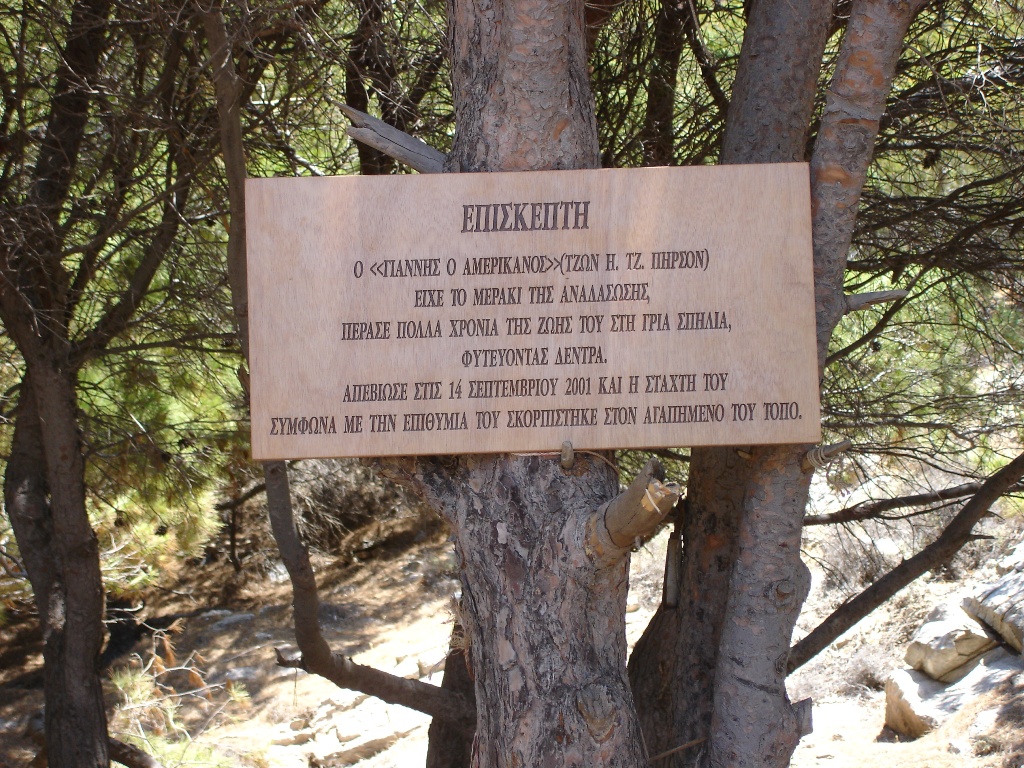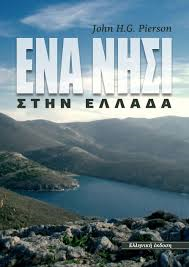Legend:
VISITOR
“Yiannis the American” (John H. Pearson), who found joy in reforestation, spent many years of his life in Old Cave, planting trees. He passed away on September 14, 2001, and as per his wishes, his ashes were scattered in his favorite place.
By Teos Romvos
As early as its dawn, human civilization identified with the tree and its fruit. Even before gatherer men learned to work the land, trees offered them easily accessible food, while later they provided wood for making tools, homes, ships and clothing fibers, and with roots for medicinal purposes.
In the stories that those first men told around the fire, the world had the form of a gigantic tree, which either touched the ground and reached the sky, or was upside down, its roots grazing the universe.
The tree’s fruit became a holy symbol, and songs and circle dances started around the tree itself. The tree was exalted, deified, became a symbol of birth and of the renewal of life, of the union between man and woman. It was considered to hold the secret to eternal life and, in myths, a dragon appeared standing beside it, guarding its fruit: Hercules stole the apples from the Garden of the Hesperides right under the guardian-dragon’s nose, while Jason killed the snake that protected the tree where the Golden Fleece was kept.
In Greek tradition, the “holy” olive tree held a very important position. In 1973, one of the most ancient olive groves in the country, located in Pahi, Megara, in western Attica, was uprooted by the junta Colonels, who wished in this manner to cater to their American patrons by building an airport where the olive grove was, showing no mercy to the “holy trees” or to the protesting farmers.
At that time, a book named “An Island in Greece” was published in the USA; the book was about the life of a man living at the northern end of Syros, in the Cyclades. That man, who has since passed, was known to the locals as “Yiannis the American”, whose passion was to plant trees.
“Yiannis” first visited the Aegean in 1962, was enchanted by the islands but was also surprised when he saw the bareness of the landscape and the desertification in the islands of the Cyclades. Having received a classical education since a tender age, he recalled extracts from Homer:
[…] the island, about which is set as a crown the boundless deep.
The isle itself lies low, and in the midst of it
my eyes saw smoke through the thick brush and the wood.[1]
He also recalled as descriptions by other ancient writers who referred to the fertile soil of the islands:
And trees, high and leafy, let stream their fruits above his head,
pears, and pomegranates, and apple trees with their bright fruit
and sweet figs, and luxuriant olives.[2]
“…the soil which has kept breaking away from the high lands during these ages and these disasters, forms no pile of sediment worth mentioning, as in other regions, but keeps sliding away ceaselessly and disappearing in the deep. And, just as happens in small islands, what now remains compared with what then existed is like the skeleton of a sick man, all the fat and soft earth having wasted away, and only the bare framework of the land being left. But at that epoch the country was unimpaired, and for its mountains it had high arable hills, and in place of the “moorlands,” as they are now called, it contained plains full of rich soil; and it had much forestland in its mountains, of which there are visible signs even to this day; for there are some mountains which now have nothing but food for bees, but they had trees no very long time ago, and the rafters from those felled there to roof the largest buildings are still sound. And besides, there were many lofty trees of cultivated species; and it produced boundless pasturage for flocks. Moreover, it was enriched by the yearly rains from Zeus, which were not lost to it, as now, by flowing from the bare land into the sea; but the soil it had was deep, and therein it received the water, storing it up in the retentive loamy soil and by drawing off into the hollows from the heights the water that was there absorbed, it provided all the various districts with abundant supplies of springwaters and streams, whereof the shrines which still remain even now, at the spots where the fountains formerly existed, are signs which testify that our present description of the land is true.”[3]
[1] Homer, The Odyssey, Book 10, lines 195-197. English Translation by A.T. Murray. Cambridge, MA., Harvard University Press; London, William Heinemann, Ltd. 1919.
[2] Homer, The Odyssey, Book 11, lines 588-591. English Translation by A.T. Murray. Cambridge, MA., Harvard University Press; London, William Heinemann, Ltd. 1919.
[3] Plato, Critias, 111(b)-111(d). Plato in Twelve Volumes, Vol. 9translated by W.R.M. Lamb. Cambridge, MA, Harvard University Press; London, William Heinemann Ltd. 1925.
I presume that something wondrous happened during that journey, something that made “Yiannis” think about what made life worth living, and dedicate the rest of his days to planting the trees. Then again, maybe he only wished to prove that forests could revive in the desertified islands of the Aegean. For this reason, in 1964 he returned to Greece with his son, John Jr., and bought some 200 acres (800 “stremma”) of land in Apano Meria, Northern Syros, near the cove of Grammata. He put up a fence all around the land to keep the goats away, labored hard to dig two wells in the rocky ground, and at first created a plant nursery where he would start the long process of restoring the soil of the island by planting trees. With great determination and patience, he planted tens, hundreds, thousands of seeds and waited for his vision to become true: to give back life to the denuded area.

For the people living in Apano Meria, “Yiannis” became a local, whom they watched coming and going as far as Kampos, the settlement where the road stops, and then walk for about an hour along the path, in the rain or the cold, until he reached the far end of the island and his beloved trees, which the locals considered “useless old wood”.
Each year, “Yiannis” would spend many months there, tending to the trees or overseeing the care they received. He started learning from the farmers in Apano Meria the manner of dryland farming, and after digging ditches on hillsides sheltered from the wind, he planted rows of saplings, mainly Aleppo pines. He would dig a hole around the root of every tree to gather rainwater and moisture, while constantly tilling the soil, which remained soft and water evaporation decreased. He regularly enriched the soil with the required micronutrients, such as nitrogen, which is rare in the Grammata area.
In those first years, he planted more than 10,000 trees. Some 5,000 of those survived, some just a little larger than a bonsai tree because of the strong winds, some others however reaching up to 6 meters. Even though in the area the soil is infertile, rain is rare, the summer sun is ruthless, the winds constant and strong and the salinity of the sea burns the plants, the trees flourished. And today, thanks to “Yiannis’” labors, the area of Grammata, which had been a safe harbor for windswept seafarers since very ancient times, has become a heavenly anchorage for modern vessels, while the tall trees abounding in the Old Cave -or GriaSpilia- beach, more commonly known today as “the American’s” beach, have become a favorite destination for the occupants and the visitors of the island.
“Yiannis” recorded those first years, filled by pure altruism and by the passion to restore the natural beauty of the forest to a piece of land so that it would become as it was a few hundred years ago, in his book, “An Island in Greece”.
His toil, a toil that in earlier times would have looked like old Santiago’s battle with the sharks and Captain Ahab’s fight with Moby Dick, of all those idealized characters of American literature, filled with man’s passion to dominate over nature, now took a different form, because “Yiannis” realized that there is a vital need to repair the destruction that man has caused nature in the meantime. “It was man and the voracious goat that reduced the islands to mountains full of rocks and spiny brooms, not the lack of rain”, he used to say. “The rain probably stopped falling because vegetation disappeared, this is why we must learn how to restore the forests”.
“Yiannis” (John Pearson), a US Government and UN economist, who became famous in the USA for the trees he planted in Grammata, passed away on September 14, 2001, in Massachusetts, USA, at the age of 95; as per his last wishes, his ashes were scattered in his favorite forest, at “the American’s”.
An island in Greece, by John Pearson
https://mega.co.nz/#!acVnUTKZ!p3wQ5T–FyEOBuYHb80pTST_WnvdfSQntspOZw1xrp-4
Translation: Mata Salogianni (Μάτα Σαλογιάννη) / Edited by Rupert Smith


